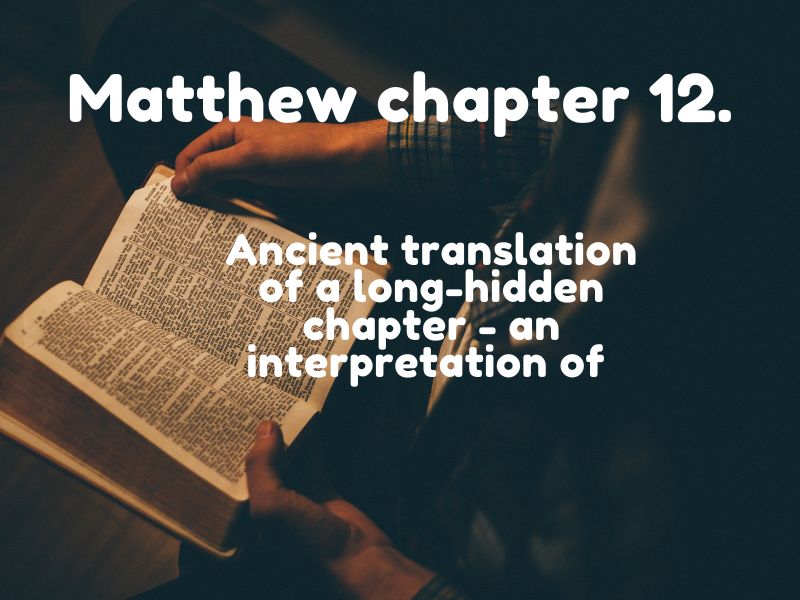Ancient manuscripts are always a momentous occasion, particularly when they shed new light on the early history of Christianity. Recently, a scientist discovered a Hidden Chapter in the Bible using ultraviolet photography.
The researcher uncovered a hidden chapter chapter of the bible that was part of one of the earliest translations of the Gospels, the Old Syriac translation. The discovery is significant as only three known examples of the Old Syriac translation exist. In this article, we will delve into the details of the discovery, including how the text was hidden and the find’s significance.
The Hidden Chapter in the Bible
The discovery of a hidden fragment of one of the earliest translations of the Gospels by a scientist using ultraviolet photography has caused a stir in academic and religious circles alike.
Grigory Kessel, a medievalist at the Austrian Academy of Sciences, used photography to uncover a “new” ancient translation of a long-hidden chapter – an interpretation of Matthew chapter 12.
Matthew Chapter 12 – Hidden Chapter in the Bible
The chapter was initially translated as part of the Old Syriac translations about 1,500 years ago. Still, the parchment it was written on was reused, mostly erasing the original translation of the Biblical New Testament.
The discovery marks the fourth known manuscript containing the Old Syriac translation of the Gospels. It shows how productive and essential the interplay between modern digital technologies and basic research can be when dealing with medieval manuscripts.
The discovery highlights the crucial role that technology is playing in the discovery of ancient texts and the preservation of human history. It also reminds us of the importance of preserving cultural heritage and ensuring that future generations have access to the knowledge and wisdom of the past.
Discovery of the Hidden Chapter in the bible
Grigory Kessel, a medievalist at the Austrian Academy of Sciences, used ultraviolet photography to find the hidden chapter of the Old Syriac translation. The chapter interpreted Matthew Chapter 12 and was initially translated about 1,500 years ago. However, the parchment on which it was written was reused a couple of hundred years later when parchment became scarce in the region. The original translation of the Biblical New Testament was mainly erased, and a document with one layer of text hiding the erased remains of another is called a palimpsest. Kessel’s find is a double palimpsest because the parchment was significantly used.
Fourth Manuscript of Old Syriac Translation
Until recently, only two manuscripts containing the Old Syriac translation of the Gospels were known to exist. One resides in the British Library in London; the other was a palimpsest discovery at St. Catherine’s Monastery at Mount Sinai. As part of the “Sinai Palimpsests Project,” a third manuscript was recently unearthed. Kessel’s find marks the fourth manuscript, a translation from the 3rd-century text likely copied in the 6th century. The parchment was housed in the Vatican Library.
Importance of the New Discovery
The discovery of the hidden chapter in the bible significantly contributes to our understanding of early Christian texts. During fragments of New Testament text date back to the original writings from the 3rd century, the oldest known surviving complete manuscript of the New Testament is the Greek Codex Sinaiticus, which is dated to the 6th century.
The Old Syriac translations can date from before the 6th century, but they are primarily found in palimpsests preserved in the erased layers of parchment. Claudia Rapp, director of the Institute for Medieval Research at the OeAW, praised Kessel for his discovery and emphasized the importance of modern digital technologies and basic research in dealing with medieval manuscripts.
Effect of the hidden chapter in the Bible on bible scholars
The discovery of the hidden chapter of the Bible has significant implications for bible scholars. It sheds new light on early translations of the Gospels and provides a fresh perspective on the evolution of biblical texts.
The discovery challenges existing assumptions about the history of biblical translations and highlights the need for continued research and exploration.
It also demonstrates the value of new technologies in uncovering lost knowledge and preserving cultural heritage. Overall, the discovery has sparked renewed interest and debate among scholars and is likely to lead to further discoveries and insights in the field of biblical studies.
Impact on Christian Believers
The discovery of the hidden chapter in the Bible is likely to have a significant impact on Christian believers. For many, it reinforces the historical authenticity of the Gospels and provides a deeper understanding of the early development of Christian doctrine. It also offers a glimpse into the translation process of the Bible and the challenges that early translators faced.
The discovery may inspire renewed faith and interest in the Bible for some believers, while others may view it as an opportunity to reexamine their beliefs in light of new information. Ultimately, the impact on Christian believers will depend on their individual interpretations and beliefs, but the discovery has the potential to deepen and enrich their understanding of the Bible and its historical context.
https://www.youtube.com/watch?v=nDZpuA5qnKY
Conclusion:
The discovery of a hidden chapter in the bible is always an exciting moment, mainly when it is one of the earliest translations of the Gospels. Grigory Kessel’s use of ultraviolet photography to find the hidden chapter represents an impressive achievement of research know-how.
The discovery is significant as only three known examples of the Old Syriac translation exist. It demonstrates the importance of the interplay between modern digital technologies and basic research when dealing with medieval manuscripts. The finding significantly contributes to our understanding of early Christian texts and will no doubt inspire further research.
Sources:
1. www.msn.com








